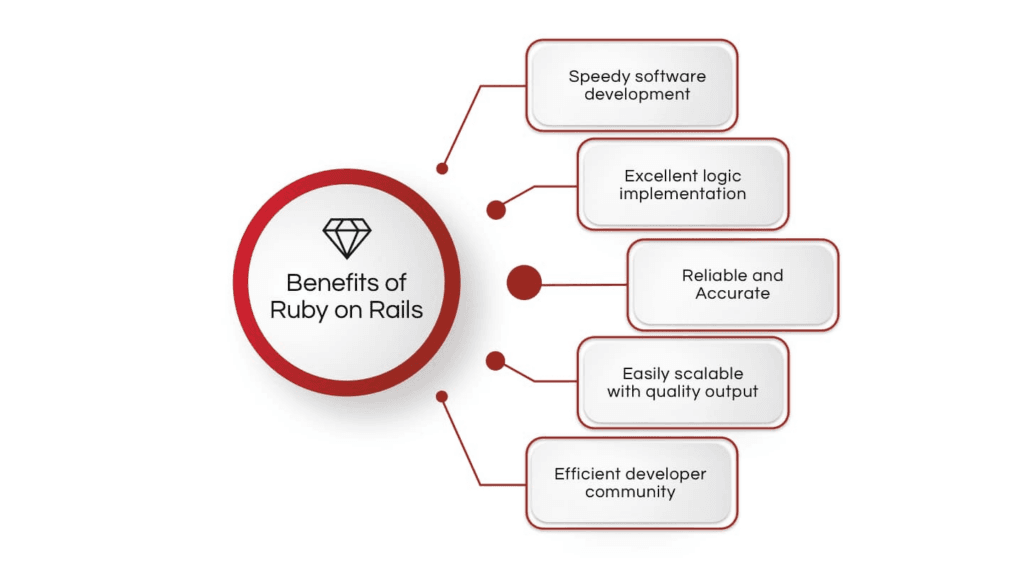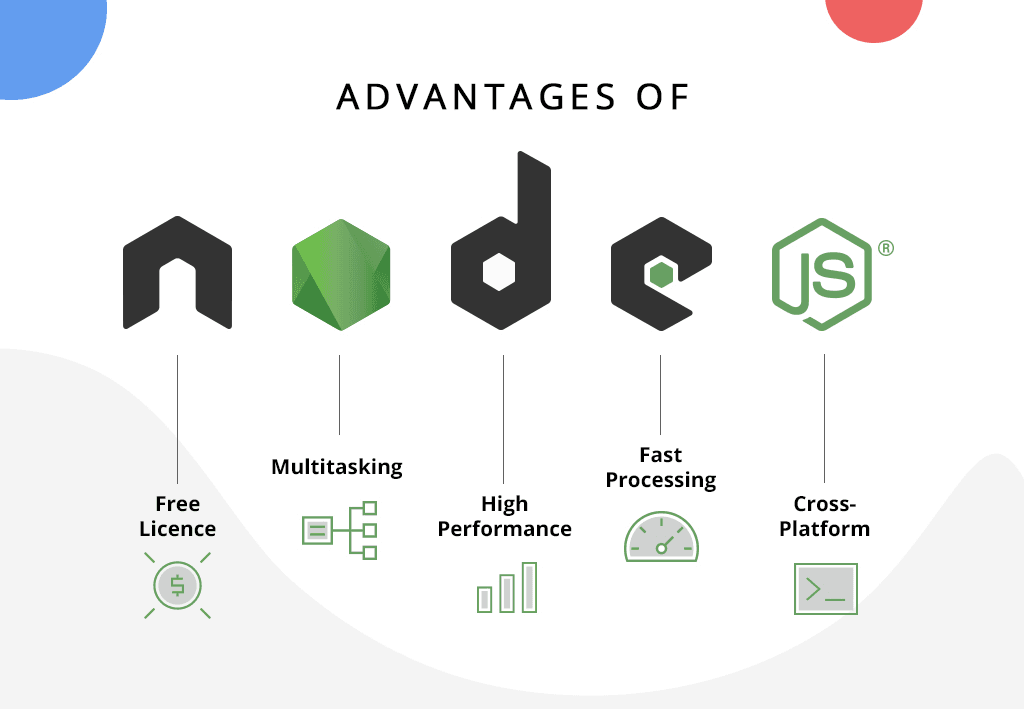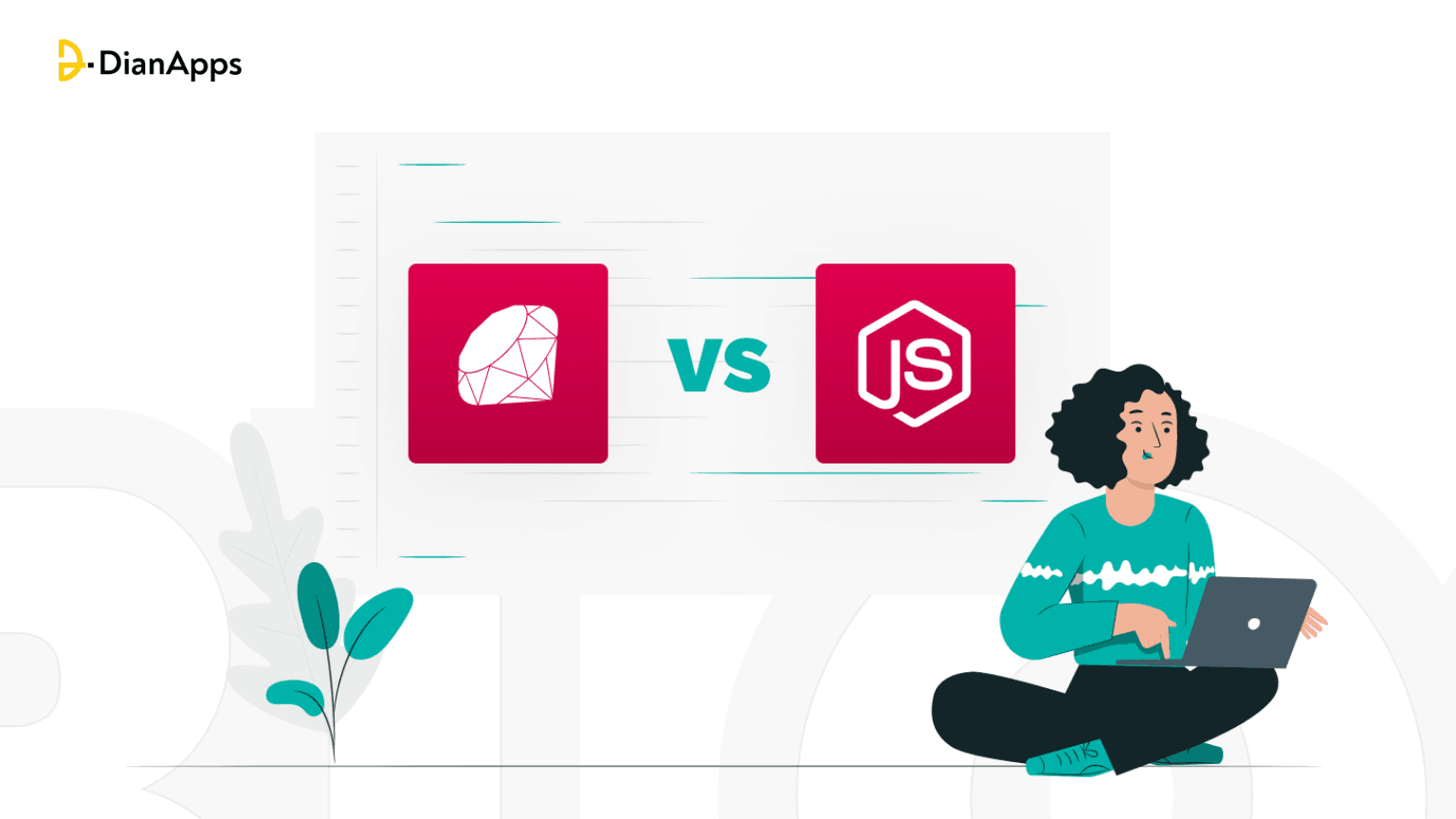New web development frameworks and tools regularly hit the market as a result of technological advancement. Even though this gives developers and startup owners a wide range of options, this variety has drawbacks. In this competitive era, when quick and effective outcomes are essential, it also generates a great deal of confusion. This is why there are always arguments between different technologies, like Node.js vs. Ruby on Rails.
The question whether or not the web framework is preferable for projects has been the subject of a heated discussion.
We’ll compare RoR with Node.js in this article based on the project goals you have in mind, whether they be performance, scalability, architecture, or any other aspect you might be interested in.
Introduction to Ruby on Rails and Node.js
Ruby on Rails and Node.Js are the two well-known backend frameworks, used by many website development companies across the world. On a contrasting note, Ruby on Rails is a framework while Node.Js is a JavaScript-led environment for running server-side applications. This article compares Ruby on Rails and Node.js based on six key factors to make it easier for businesses to decide which one best meets their requirements. Choosing a backend technology can be difficult. You will clearly understand both frameworks and how they differ by the time the article is finished.
Ruby on Rails
Ruby is a dynamic, and open-source programming language that focuses on simplicity and productivity. Nonetheless, Ruby on Rails (RoR) is a mobile app development framework that operates mainly on the Ruby language. RoR supports and promotes the usage of web standards like JSON or XML for data transport, CSS for styling, and HTML for generating user interfaces.
RoR offers a number of advantages that appeal to startups, small businesses, and middle-sized corporations. For managing internal logic, routine, data, cloud computing, etc., Rails was created.
Some interesting data on Ruby on Rails are provided below:
- According to StackOverflow, Ruby on Rails will rank as the 14th most used web framework and technology in 2022.
- RoR reportedly runs approximately 400K websites and has about 180K unique domains, as per SimilarTech.
- On GitHub, more than 2 million users use Ruby on Rails.
- One of the largest/major project shares was held by Computer Electronics and Technology, at 6.64%. They share a common foundation with the other industrial verticals: RoR.
Companies that Use Ruby on Rails
Popular businesses that utilize Ruby on Rails include:
- Airbnb: Since its inception, Airbnb has utilized Ruby on Rails. The framework is an essential component of Airbnb’s technology stack.
- GitHub: With over 200 million code repositories and 32 million monthly users, GitHub has a Ruby on Rails backend. The app was created by the founders of the business seven years ago.
- Shopify: With over 820,000 sellers using their service, Shopify is a great example of an advanced yet well-structured and user-friendly Ruby on Rails ecommerce platform.
- Fiverr: Ruby on Rails was used to power their online service marketplace at launch, and it is still used today.
Pros of Ruby on Rails

There are various advantages to using Ruby on Rails. We’ve listed the top ones below:
1. Development speed
Ruby on Rails Developers may produce applications fast using the framework because of its well-developed architecture of modules, effective package management system, and expressive and concise Ruby language features.
2. Big Infrastructure
Ruby on Rails includes a built-in web server and a database with generators to simplify the process of creating websites.
3. Large community
The vibrant and supportive community of Ruby on Rails is yet another fantastic feature. It’s one of the most used frameworks on GitHub, and the Ruby community has probably already incorporated all of the features you can imagine.
4. Best practice
Rails was developed with the intention of establishing best practices for web app development services, and it includes all the essential frameworks and modules for implementing these guidelines in development projects.
5. Code quality
Ruby third-party code is noticeably better than other languages in terms of quality.
Cons of Ruby on Rails
Some of the flaws in Ruby on Rails are covered below:
1. Less flexibility
It could be challenging to modify Ruby on Rails to produce a one-of-a-kind application with distinctive characteristics.
2. Runtime speed and performance
Scaling your applications becomes challenging due to Ruby on Rails’ slow runtime, which is one of the most frequently used criticisms of the framework. Twitter stopped using Ruby on Rails for its search engine for the same reason.
3. Boot speed
Rails’ slow boot time is a common complaint among Ruby on Rails developers. Depending on your gem dependencies and file requirements, starting up might take a while.
4. Difficult debugging
Ruby on Rails is a complicated framework with many layers, making it challenging to troubleshoot a Rails application. It may take some time to identify a mistake in the mixture.
Know how to build a scalable Ruby on Rails Development Team: In-House vs. Outsourcing
Node.js
Node.Js – an open-source framework based on the JavaScript runtime used for executing JS code. This is undoubtedly one of the quickest engines on the market and is based on the Chrome V8 Engine.
Node.Js uses an event-based, onon-blocking I/O mechanism which helps it to be more efficient and lightweight.
Here are some interesting stats about Node.js:
- StackOverflow predicts that in 2022, the platform and technology will be most widely used.
- The technology that is most desired in 2022 is in second place.
- 8th most popular platform by 2022.
Companies that Use Node.js
Some of the well-known companies that use Node.js are:
- Netflix: Netflix started using Node.js to provide high-volume web streaming to more than 182 million subscribers, and they hoped to expand their use of Node.js to include content creation.
- Uber: Uber’s primary trip execution engine was created in Node.js due to its simplicity, single-threaded processing and asynchronous primitives.
- PayPal: As a replacement for Java, PayPal decided to use JavaScript for web applications from the browser all the way to the backend server.
- NASA: Following a bad incident in orbit, NASA chose to employ Node.js to improve data security and maybe save lives.
- LinkedIn: Due to its scalability and performance effectiveness, LinkedIn ceased using Ruby on Rails and switched to Node.js.
Pros of Node.js

We’ve listed the most common of Node.js’s advantages:
1. Easy to learn
Node.js is based on JavaScript, so if you already have a strong foundation in programming and are familiar with JavaScript, learning it can be a lot simpler. There are lots of tutorials and courses available to make learning fun.
2. Community
A supportive and insightful community means a lot of engagement. There is a sizable developer community that supports Node.js. The Node package manager, or npm, is one of the most well-liked and quickly growing software repositories. You can use the many libraries and reusable templates provided in your project.
3. Seamless JSON support
While other backend technologies, like Ruby on Rails development framework, can communicate using the JSON format, Node.js does so by using JavaScript rather than converting between binary models. When building RESTful APIs using a NoSQL database like MongoDB, this is quite helpful.
4. Highly extensible
Since Node.js is well known for being highly extendable, developers can modify and extend it to suit the requirements of their projects.
Cons of Node.js
Here are some of Node.js’s drawbacks, that makes the framework, a lesser suitable choice for your project:
1. Unstable API
Node.js frequently experiences incompatible API changes. The biggest drawback of utilizing Node.js development framework is the hefty code modifications that result from these incompatibilities.
2. Immaturity of tooling
Despite the high level of dependability of the core Node.js modules, many of the packages in the npm repository are of poor quality and have inadequate documentation. Finding the ideal package for your needs may be challenging as a result.
3. Not suited for CPU-intensive tasks
The other significant flaw Node.js currently has is that it cannot handle CPU-bound activities. Only I/O-related tasks (like web servers) can use it.
4. Callback issue
Node.js heavily relies on callbacks, which are the processes that are launched once each task in the queue has been finished. Keeping a lot of queued processes running in the background, each with its own callback, has a direct impact on the quality of the code.
Let’s Compare Ruby on Rails and Node.js!
When selecting a web framework for your project, many things need to be taken into account. We will now compare the advantages that Node.js app development has to offer to those of Ruby on Rails. The following highlights the key distinctions between Node.js and Rails:
1. Execution
The market for JavaScript has existed for many years. Therefore, Node.js can easily benefit from all the pre-built solutions and experiences that JavaScript has to offer. Node.js still falls short of the majority of comprehensive backend programming frameworks, though. As a result, Node.js takes a long time to execute problem problems to perfection.
Ruby on Rails, on the other hand, is one of the easiest web frameworks to use and learn. Numerous tools and syntactical features in Ruby on Rails allow for quicker development and execution.
Know how to use Node.Js for Backend Web Development in 2023
2. Scalability
When we talk about of web app development, scalability is a major aspect. Node.js is very scalable because of its event-driven architecture and non-blocking I/O operations. It is useful for creating real-time applications like chat apps or online games since it can manage a huge number of concurrent connections very easily.
Compared to Node.js, Ruby on Rails is less scalable. It utilizes a single-threaded paradigm, which limits the number of requests it can process at once. However, by enabling it to handle multiple requests concurrently, tools like Unicorn and Puma are helpful. These tools help mitigate the limitations of the single-threaded architecture, thereby improving the scalability of Ruby on Rails-based applications.
3. Performance
Due to its integration of JavaScript’s async and non-blocking features, Node.js fosters the development of manageable little jobs. Additionally, multitasking is quicker and more effective thanks to its V8 JavaScript engine. Node.js uses a single-threaded event loop architecture for backend programming. This guarantees that it manages several concurrent requests efficiently.
Node.js has the capacity to handle several requests at once. The performance of this platform is preferred by several tech companies. For instance, after switching from Java to Node.js, PayPal experienced a doubling of requests per second and a reduction of 35% in the typical response time.
In terms of performance, Ruby on Rails falls short of other popular web frameworks. Garbage collection is not effective enough for Ruby because it is an interpreted language. The garbage collector will occasionally enter the system, halt it, and use the mark-and-sweep algorithm to clear out memory that is no longer being referenced. This takes a lot of time and occasionally slows down the RoR app. However, it doesn’t happen often.
That being said, hire Ruby on Rails developers to create fantastic web applications that perform well. The RoR development standards must be strictly adhered to in order to accomplish this.
4. Application Architecture
The JavaScript callback mechanism and event-based model are the foundations of the Node.js processing model. Developers can also use the MVC/ MVP architecture pattern, which makes it easier for newcomers to onboard and isolate issues in the application codebase. Additionally, the platform supports asynchronous communication between its various components and generates multiple views of the same data.
On the other hand, Ruby on Rails makes use of the standard MVC (Model View Controllers) architecture. The model layer contains all the guidelines for managing data and storing business logic. The View is in charge of the application’s front end, and the controller is in charge of the application flow. Over the configuration rule, it adheres to convention. This indicates that the technological issues have already been resolved. So the concentration can be diverted more on solving business issues.
Also read: Latest Must-have Web Developer Skills Needed In Front-End Programming
Node.js vs Ruby on Rails: Which should be used?
It’s time to choose a platform now that you’ve read the thorough comparison of Ruby on Rails and Node.js. Let’s take a final look at the frameworks that might be most appropriate for the various applications.
When to use Ruby on Rails?
For CPU-intensive applications that need quick development, Ruby on Rails is a great option. If you want to create a social networking site or an e-commerce platform that can handle a lot of traffic, Rails is a particularly wise choice.
When to use Node.js?
If you want to create a real-time application that must handle numerous concurrent requests and data transfers between client and server, such as chat or video chatting apps, Node.js is an excellent option. You should use Node.js first before switching to Ruby on Rails if performance or scalability are issues for you.
Summary
Ruby on Rails and Node.js are both potent web and mobile application frameworks. The decision of who will win can be very difficult. The pros and cons of both technologies must be weighed by web app developers and startup owners against their own business models.
Node.js might be a great option if scalability or performance are your main concerns. Ruby on Rails, on the other hand, might be the better framework for you if you want to create an application that can manage high volumes of traffic and CPU-intensive tasks.
However, keep in mind that neither the language nor the framework matters. All that matters when creating an application is proper execution and knowledge. Hire a back end developer from DianApps to create the desired product and surpass the expectations of your end users.
If you have any further inquiries about either framework, please don’t hesitate to get in touch with us personally.










Leave a Comment
Your email address will not be published. Required fields are marked *